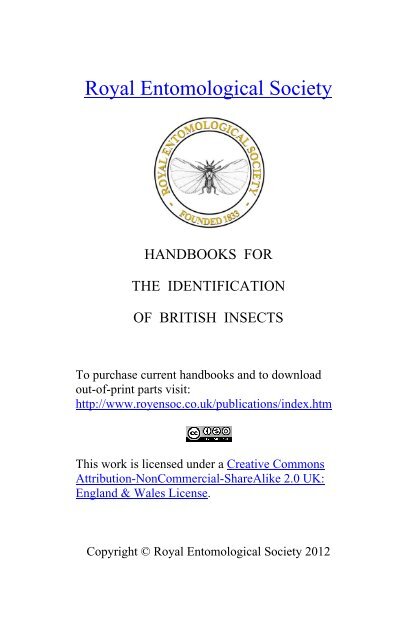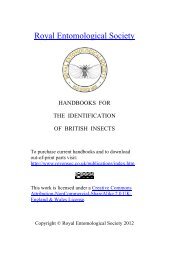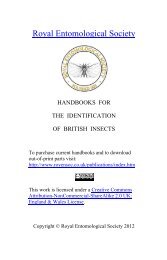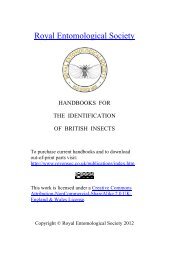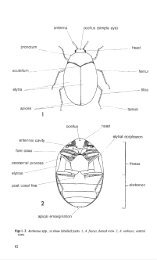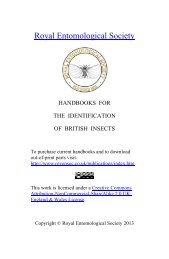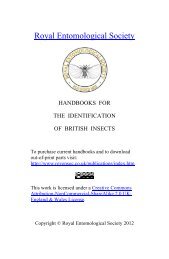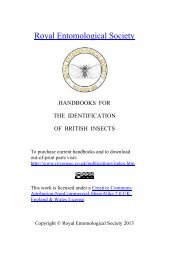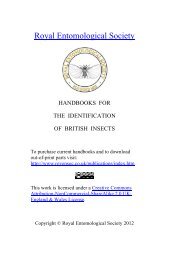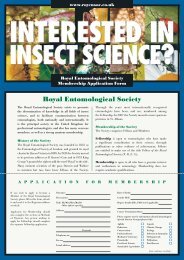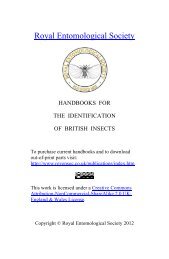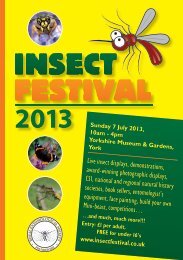Vol 6 Part 3a. Hymenoptera - Bethyloidea - Royal Entomological ...
Vol 6 Part 3a. Hymenoptera - Bethyloidea - Royal Entomological ...
Vol 6 Part 3a. Hymenoptera - Bethyloidea - Royal Entomological ...
Create successful ePaper yourself
Turn your PDF publications into a flip-book with our unique Google optimized e-Paper software.
<strong>Royal</strong> <strong>Entomological</strong> SocietyHANDBOOKS FORTHE IDENTIFICATIONOF BRITISH INSECTSTo purchase current handbooks and to downloadout-of-print parts visit:http://www.royensoc.co.uk/publications/index.htmThis work is licensed under a Creative CommonsAttribution-NonCommercial-ShareAlike 2.0 UK:England & Wales License.Copyright © <strong>Royal</strong> <strong>Entomological</strong> Society 2012
ROYAL ENTOMOLOGICALSOCIETY OF LONDON <strong>Vol</strong>.V I, <strong>Part</strong> 3(a)HANDBOOKS FORTHE IDENTIFICATIONOF BRITISH INSECTSHYMENOPTERABETHYLOIDEA(excluding CHRYSIDIDAE)ByJ. F. PERKINSJanuary, 1976LONDONPublished by the Society.p Queen'• Gate, S.W.7
HANDBOOKS FOR THE IDENTIFICATION OF BRITISH INSECTSThe aim of this series of publications is to provide illustrated keys tothe whole of the British Insects (in so far as this is possible), in ten volumes,as follows:I. <strong>Part</strong> 1. General Introduction., 2. Thysanura., 3. Protura., 4. Collembola., 5. Dermaptera andOrthoptera., 6. Plecoptera., 7. Psocoptera., 8 . .Anoplura.II. Hemiptera.Ill. Lepidoptera.IV. and V. Coleoptera.<strong>Part</strong> 9. Ephemeroptera., 10. Odonata., 11. Thysanoptera., 12. Neuroptera.,,13. Mecoptera.14. Trichoptera., 15. Strepsiptera., 16. Siphonaptera.VI. <strong>Hymenoptera</strong> : Symphyta and .Aculeata.VII. <strong>Hymenoptera</strong>: Ichneumonoidea.VIII. <strong>Hymenoptera</strong> : Cynipoidea, Chalcidoidea, and Serphoidea.IX. Diptera : Nematocera and Brachycera.X. Diptera : Cyclorrhapha.<strong>Vol</strong>umes II to X will be divided into parts of convenient size, but it isnot possible to specify in advance the taxonomic content of each part.Conciseness and cheapness are main objectives in this series, and eachpart is the work of a specialist, or of a group of specialists. .Although muchof the work is based on existing published keys, suitably adapted, muchnew and original matter is also included.<strong>Part</strong>s are issued, separately paged and priced, a,s they become available.A second (revised) edition of A Check List of British lnseds, by G. S. Kloetand W. D. Hincks, is being issued as an extra, eleventh, volume in this series.The Society is indebted to the <strong>Royal</strong> Society for a grant towards the costof initiating this series of Handbooks.A list of parts so far published appears on the inside and outsideback covers.
HYMENOPTERASuperfamily BETHYLOIDEA (excluding Chrysididae)By J. F. PERKINSINTRODUCTIONThe Chrysididae, which are familiar insects, seem at first sight verydifferent from the other much rarer <strong>Bethyloidea</strong> but intermediate generaoccur in the American and Indo-Australian faunas. The Bethylidae aresmall or moderate-sized insects, usually black and with the same number ofantenna! segments (12 or 13) in both sexes, whereas in typical aculeates themale usually has 13 and the female 12. The larvae mostly live as externalparasites of coleopterous or less often lepidopterous larvae. No real nest ismade but in Bethylus the female takes her stung and paralysed prey into asheltered place or hollow stem, lays several eggs on the prey and stands watchover them until after they have hatched. Some other Bethylidae show alimited amount of maternal care. Only three British species are at all commonand three or four others are introduced species, found in warehouses.The position of the Dryinidae and Embolemidae is much more dubious.They have been placed traditionally near the Bethylidae though they have10 antenna! segments. The North American catalogue (1st ed. 1951) placedthem in the Sphecoidea. Since Harpagocryptus Perkins has now been synonymizedwith Olixon Cameron (cf. Richards, 1939: 293) there is a possibilitythat they should be placed in the Pompiloidea.As far as is known, all Dryinidae and Embolemidae (one AmericanAmpulicomorpha bred) are parasites of Homoptera, mainly cicadellids anddelphacids. The female lays an egg between two overlapping sclerites of thehost (usually nymph) and after the first instar the larva begins to projectexternally in a sac formed of successive moult-skins. In the Aphelopinaethe sac includes much more host-tissue. In the Dryinidae, the female(except Aphelopinae) has evolved an extraordinary chela on the fore tarsus,the fifth segment and one claw being enlarged and opposable. Nearlyalways the parasites of delphacids have peg-like lamellae on the enlarged claw,whereas parasites of cicadellids do not. Parasitized homopterous nymphsare sometimes quite common in the field but adult Dryinidae are relativelyrare, though sometimes found in some numbers in very restricted localities.KEY TO FAMILIESColours metallic. Antennae with 12-13 segments. Species fully winged, sexualdimorphism slightChrysididae (not dealt with in this part)- Colours not m etallic. Species sometimes apterous (usually in ~ only ), sexual dim orphismoft en marked ...... . ........... ... ........ . ....... .. .. . ... .. ... . .. 22 Antennae with 12-13 segments, inserted low down on face. Usually black, ratherlong and narrow species. A few are apterous or brachypterous.Bethylidae (p. 3)
2 VI (<strong>3a</strong>). HYMENOPTERA : BETHYLOIDEA- Antennae with 10 segments, inserted on a prominence n ear dorsal margin of3clypeus .............. . ........... . ...... .. .... . ... . . ... . ...... . . .. ..... 3
BETHYLIDAE 3from Argyll in Scotland to the South coast of England. Both sexes arefound in August, September and October; the females hibernate and areactive again in late April and May.KEY TO FEMALES1 Antenna somewhat longer than body, with distal segments three to four times aslong as broad, pedicel more than twice as long as broad; colour uniformly reddishbrown;head laterally, centrally with close, small punctures and with scatteredlarger punctures; contrasting conspicuously with the finely punctate top of thehead. 4--5 mm.ruddii West woodNorfolk; Surrey; Berks.; Hants.- Antenna not longer than body, with distal segments at most 3 times as long as broad,pedicel little longer than broad; colour uniformly yellowish brown; head laterallyvery finely punctate and similar in sculpture to the top of the head. 3·5 mm.antennalis KiefferOnly one British specimen known: Somerset, Long Ashton, 18.x.1927 (G. L.Walton).Family BETHYLIDAEAlthough Evans (1964) divided the Bethylidae into three subfamilies,these are not indicated here as with the very limited fauna occurring in theBritish Isles this adds unnecessary complications to the identification of thespecies. With few exceptions the species are almost entirely black or piceousand thus colour plays little part in their separation.KEY TO GENERAAntenna with 12 segments ........................................ . ...... . . 2Antenna with 13 segments .... ........... . ..... . ............ . .............. 42 Fore wing with Rs absent (fig. 2); if brachypterous then wings very small and scalelikeor apterous, and with basal flagellar segments transverse and malar spacelonger than breadth of pedicel. Claws simple Cephalonomia (p. 7)- Fore wing with Rs present (fig. 3); if brachypterous then wings rarely very short withbasal flagellar segments at least a little longer then broad and malar space conspicuouslyshorter than breadth of pedicel ................................. 33 Length less than 1· 8 mm; venation indistinct but fore wing with R 1 strongly thickenedbefore pterostigma (fig. 3); Rs+M absent and sometimes cells Rand M +Gu 1 notenclosed: never brachypterous; claws simple.Warehouse or outdoor species.Plastanoxus (p. 6)- Length 2·2-5 mm; fore wing (fig. 4) with R 1 not thickened distally; Rs+M presentas a short stump; sometimes brachypterous: claws with a strong basal lobe andstrongly curved apically. Outdoor species. Bethylus (p. 8)4 Fore wing (fig. 5) with proximal abscissa of Rs+M present; first abscissa of Rsstrongly thickened where it joins R; face with the central carina of the clypeusstrongly produced upwards between the antenna! sockets; ~fully winged; clawswith a strong basal lobe, strongly curved apically. Goniozus (p. 8)- Fore wing (figs. 6, 9, 10, 23) with proximal abscissa of Rs+M absent; first abscissa ofRs not thickened where it joins R; face with the central carina of clypeus notproduced upwards or (Holepyris) with the carina very weak; ~wingless in somegenera; claws with a weak basal lobe, only moderately curved apically, sometimeswith a pre-apical tooth .. .. ............ . .. . ........... ............... ... . 55 Metanotum occluded centrally (figs. 7, 8) so that apex of scutellum and base of propodeumare contiguous; costal cell occluded (figs. 6, 9, I 0); ~ fully winged or brachypterous;ocelli present; eyes moderately large; black ....................... 6- Metanotum well developed centrally with an emargination or fovea opposite apex ofscutellum (fig. 22); cJ costal cell well developed (fig. 23); ~ wingless, ocelli absent,eyes absent or very small; entirely testaceous .. ........ .. . . ................ 86 Rs conspicuously shorter than M (basal vein) (fig. 6); upper basal cell glabrous,lower basal cell with a few microtrichiae in the lower apical corner; head, thorax,
4 VI (<strong>3a</strong>). HYMENOPTERA : BETHYLOIDEAfemora and tibia and veins surrounding basal cell with sub-erect black bristles;malar space distinct; gaster with black bristles particularly laterally and apically;'i' winged. Eyes glabrous; scutellar fovea entire Laelius (p. 5)- Rs conspicuously longer than M; upper and lower basal cells with abundant microtrichiae;head, thorax, femora, tibia and veins surrounding basal cell at most withsordid hairs; malar space extremely short, 'i' sometimes wingless and sometimeseyes absent . . ..... .. .. . ......... ..... ... . ... . .. . ............... . . . ... . . 715 ~~-~- -- -------FIGs. 7-16.-7, Epyris niger, scutellum; 8, Epyris bilineatus, scutellum; 9, Holepyrishawaiiensis, wings; 10, Holepyris sylvanidis, wings; 11, Cephalonomia tarsalis, scutellum;12, The same, head of
BETHYLIDAE 57 Scutellar fovea of represented by a pair of lateral pits (fig. 7, 8) or by a groovewhich is interrupted centrally; clypeus with no notch on each side of central lobe.Outdoor species Epyris (p. 5)Scutellar fovea entire; clypeus with a distinct notch at the base of each side of thecentral lobe. Warehouse species. Holepyris (p. 5)8 cr. eyes hairy; gaster piceous, with apices of segments paler; clypeus with a projectingsub-trapezoidal central lobe which is truncate anteriorly; scutellum projectinginto the anterior incision ofmetanotum; claws simple; (fig. 22), propodeumviewed dorsally strongly narrowed from about middle to base where there are apair of anteriorly projecting processes separated by a semicircular incision; eyesabsent; mesonotum elongate; head, thorax and gaster infuscate.Pseudisobrachium (p. 9)cJ, eyes glabrous; gaster red; clypeus with a broadly rounded central lobe; metanotumnot excised anteriorly; claws with a preapical tooth; , propodeum with the maximumconstriction behind spiracles, broadly in contact with mesoscutum: eyes smallbut present: mesoscutum transverse; an entirely pale testaceous species.Pristocera (p. 9)Genus Epyris W estwoodThree species of this genus were recorded by Richards (1939). However,M6czar (1966) found the Marshall specimen of Epyris brevipennis Kieffer inthe Hungarian Museum of Natural History and it proves to have beencaptured in Brittany, not in England. It is therefore excluded from theBritish list. The known hosts of the genus are larvae of Tenebrionidae.KEY TO SPECIES1 Head and pronotum dorsally dull and densely coriaceous, with distinct punctures;lateral ocelli separated from occiput by a distance approximately equal to POL; eyes hairy; front tarsus with segments 2-3 subcylindrical, 4 cordiform; scutellarfovea (fig. 7) represented by an interrupted groove; mid-tibia only hairy.niger WestwoodSurrey, Kent, Hants., I. of Wight, Devon. 3 viii; vii-vi (hibernates).Head and pronotum dorsally weakly coriaceous, with distinct punctures and shiningin . with fine punctures and rather shining in er; lateral ocelli separated fromocciput by distance equal to 0·75 POL in cJ, 0·5 POL in ; eyes almost bare;front tarsus with segments 2-4 cordiform; scutellar fovea (fig. 8) represented bylateral pits only; mid-tibia outwardly and posteriorly spinose. bilineatus Thomson( = fraternus W estwood)Suffolk, Su.rrey, Hants., I. of Wight, Devon. 3 and vii.Genus Laelius Ashmead ( =Allepyris Kieffer)Only a single species of this genus is known from the British Isles. Knownhosts of the genus are species of dermestid beetles. microneurus (Kieffer)Kent: Beckenham, 1~, 9.vii.1972 (D-E. Kimmins); Berks: Ascot, SelwoodPark, 1~ 18.viii.1975 (0- W. Richards).Genus Holepyris KiefferBoth British species of this genus are cosmopolitan, and are found inwarehouses in this country. Evans (1966) has been followed in placingRhabdepyris zeae Turner and W aterston in this genus as a synonym ofHolepyris sylvanidis Brethes. The two British species are very distinct, theonly character placing them together being the form of the clypeus and thebasal sulcus of the scutellum.2*
6 VI (<strong>3a</strong>). HYMENOPTERA : BETHYLOIDEAKEY TO SPECIESNotauli absent; ~ propodeum, anteriorly with 5 longitudinal discal keels and thesculpture mainly transtriate; fore wing (fig. 9) with M meeting Sc+ R well beforestigma, ~fore wing with a dark discal spot; eyes strongly pubescent.hawaiiensis (Ashmead)Warehouses; a parasite of Phycitidae.Notauli deep posteriorly, becoming very faint or absent anteriorly; ~ propodeumanteriorly with 3 longitudinal discal keels and the sculpture mainly finely rugose;wings (fig. 10) hyaline, M meeting Se+ R close to base of stigma; eyes with extremelyshort scattered hairs, only visible at high powers. sylvanidis (Brethes)(=Rhabdepyris zeae Turner & Waterston)Warehouses; probably a parasite of Tribolium.Genus Plastanoxus KiefferIt is probable that in Britain the hosts of both the warehouse species arespecies of Laemophloeus. The outdoor one probably attacks species of Cis.KEY TO SPECIESLength at most 1·5 mm; cell R not enclosed; head and dorsum of thorax shining;propodeum coriaceous, with a pair of smooth areas posteriorly, sometimes joined,17 18 19 2021D25FIGs. 17-25.-(17-21) Head of: 17, Bethylus dendrophilus ~; 18, Bethylus fuscicornis ~;19, the same, b'; 20, Bethylus cephalotes ~; 21, the same, b'; 22, Pseudisobrachium subcyaneum~; 23, the same b' wings; 24, Aphelopus melaleucus, wings; 25, Mystrophorusformicaeformis, mandible.
BETHYLIDAE 7before the transverse carina; er with anterior ocellus far behind line of hind marginof eyes.westwoodi (Kieffer)Granaries.- Length about 2·0 mm; cell R not enclosed by pigmented veins; head and dorsum ofthorax shining; reticulation of propodeum extending further back than in P.westwoodi and head wider compared to its length. chittendenii (Ashmead)Outdoor species; S. Devon, Erme Mouth, on Stereum on rotten oak with Cis festivus(Panz.), Jl.viii. 70 (W. D. Hamilton); also with Cis in U.S.A.- Length about 1·75 mm; cell R enclosed by pigmented veins; head and dorsum ofthorax and propodeum conspicuously coriaceous throughout: er with anteriorocellus level with line of hind margin of eyes.rnunroi RichardsWarehouses.Genus Cephalonomia WestwoodTwo of the British species are found outdoors and are parasites of Ciidae.Three warehouse species are keyed, one of which, 0 . gallicola (Ashmead) hasnot previously been included in the list of British insects; as a parasite ofStegobium paniceum (L.), Lasioderma serricorne (F.) and Ptinus, its occurrencein this country may really be quite frequent, though the only material seenwas sent by the Walton and Weybridge U.D.C. to the British Museum(Natural History). It was found in large numbers in popodom, probablyfrom India, in association with Lasioderma serricorne.KEY TO SPECIES mainly pale testaceous; apterous; propodeum widening from base to the posteriorlateral angles; er fuscous with more or less pale testaceous markings; fully wingedwith the wings in part infuscate or apterous. Apterous specimens have scutellumundifferentiated from mesoscutum.gallicola (Ashmead)Warehouse species, associated with anobiids and ptinids.and er fuscous except sometimes for markings on legs and antennae; fully wingedor with scale·like wings; wings hyaline; scutellum always differentiated frommesoscutum; with dorsal surface of propodeum with parallel sides or narrowingposteriorly ....... ... ....... ......... . .............. . ........ . ... .... . .. 22 Propodeum with a distinct, central, longitudinal keel and scutellar fovea (fig. 11)conspicuous, deepened laterally into a pit. Sides of head, behind eyes, consider.ably converging and only a little longer than eyes (fig. 12). tarsalis (Ashmead)Warehouse species; a parasite of beetles in stored grain and dried fruit, especiallyOryzaephilus.- If the propodeum has an indication of a central, longitudinal keel, then the scutellarfovea is represented only by lateral pits ... . ............ .. . .. . ............. 33 Larger species, length 1·8 mm; antennae yellow with segment 1 brown. Headdistinctly rounded posteriorly; scutellar fovea represented by a pair of lateral pitsseparated by 5 to 6 times the diameter of one of them; prop ode urn coriaceousthroughout.harnrni RichardsOutdoor species; Oxford (A. H. Hamm), found 4 .viii.l918 carrying a larva(probably of Cis) on which were 4 eggs. These produced adults on 4.x.1918. Nofurther specimens have been examined.- Smaller species, length at most 1·6 mm; antenna brown to black, entirely so in er, atmost segments 2 to 4 yellow in •••••••••••••••••••••••••••• • •••••••••••• • • 44 Propodeum evenly and rather coarsely coriaceous. Fully winged. er scape shorter,as long as antenna! segments 2 + 3; sides of head more converging behind; scutellar fovea (fig. 13) represented by lateral pits separated by twice the diameterof one of them; sides of head (fig. 14) in front of eye about 0·5 length of eye.waterstoni GahanWarehouse species. A parasite of Laemophloeus larvae occurring in stored grain(see Finlayson, 1950).- Propodeum with a pair of shining areas in , the whole area shining in er before thedeclivous slope. Both sexes sometimes brachypterous, with wings represented by
DRYINIDAE 9Genus Pseudisobrachium KiefferOnly a single species known from the British Isles. The female is veryrare. (figs. 22, 23). subcyaneum (Haliday)Kent, Surrey, I. of Wight, Dorset. vm-tx. ~ found associated withTetramorium caespitum (L.) and Myrmecina graminicola (Latreille).Genus PristoceraThis genus is still included only on the evidence of the single male listedbelow. No further specimens have been seen. The female characters givenin the generic key are based on a continental specimen. depressa (F.)Salop: Netley, in the Archdeacon's close, 6' (F. W. Hope). Parasites ofElateridae.Family DRYINIDAEThis is a small and aberrant family of which the true affinities are not atpresent known. All are parasites of Homoptera Auchenorrhyncha of thesuperfamilies Cicadelloidea and Fulgoroidea. In the subfamilies other thanAphelopinae (p. ll) the female catches with her modified fore leg an adult ornymph of the host, stings it to insensibility and lays an egg on it betweentwo overlapping sclerites. The hopper soon recovers and runs about normallyagain. The larva is at first invisible but begins to show as a black ordark brown sac in a few days. This sac is composed of cast larval skins sothat with each moult an extra piece is added to the sac; there are normallyfive moults. Just before the larva is full grown it eats out all the contentsof the host which usually dies firmly fixed to the food-plant. On completionof feeding, the larva splits open the sac and crawls out. Although legless,it moves quite actively; most British species pupate on the food-plant, butsome pupate in the soil. The cocoon is of dense silk, often with an innerclosely-fitting lining.Males of some species are very rare, of others probably absent, particularlyin the Gonotopodinae. The association of the sexes is difficult and muchfurther work is needed on this problem.British species seem to have either one (e.g. Anteon brachycerum) or two(e.g. Gonotopus sepsoides) generations a year, the winter nearly always beingpassed in the cocoon. It requires considerable care and skill to successfullybring hibernating cocoons through the winter and rear the adults in thefollowing late spring or summer.KEY TO SUBFAMILIES1 Fore wing (fig. 24) with only costal cell closed by pigrnented veins; never brachypterousor wingless; ~with front tarsus not chelate APHELOPINAE (p. 11)- Fore wing (fig. 33) with costal and two basal cells clearly closed; brachypterous andwingless forms occurring; ~ with front tarsus chelate ........................ 22 Fore trochanter not or hardly longer than broad; occipital carina complete; ~mandible quadridentate, sometimes (Mystrophorus) with the posterior penultimatetooth very small (fig. 25).~ posterior angles of pronotum produced into distinct lobes; one spur on midtibia; usually fully winged, rarely brachypterous ANTEONINAE (p. 13)- Fore trochanter at least twice as long as broad; occipital carina at most presentdorsally; ~ mandible tridentate . . .......... . ............................. 33 Occipital carina present dorsally; ~. posterior angles of pronotum produced into
10 VI (<strong>3a</strong>). HYMENOPTERA : BETHYLOIDEAdistinct lobes directed towards the tegulae; mid tibia with a single long spur;British species fully winged, the fore wing with fuscous bands or spots; centralarea of metanotum normal, differentiated; er, ocelli forming a distinct triangle;maxillary palpi with 6 segments. DRYIN!NAE (p. 25)Occipital carina absent; ~. posterior angles of pronotum not produced; mid tibiawith no spur; British species wingless; central area of metanotum not differentiated;
APHELOPINAE 11Subfamily APHELOPINAEThis subfamily contains only the genus Aphelopus. The British species,so far as is known, attack Cicadellidae of the subfamily Typhlocybinae. Theegg and at least the first-stage larva are internal and the latter is surroundedby a peculiar hypertrophied mass of host tissue. The second instar breaksout of this mass and projects in a sac composed of larval skins and of verydifferent appearance from those of other Dryinidae. It projects from theanterior part of the abdominal pleura and lies along the side of the abdomen.The sacs vary in colour from yellow to black.Genus Aphelopus DalmanIn determining species, it is essential to examine the genitalia of the males;the females are much more difficult to place.KEY TO SPECIES(Males)Head with at most the mandibles pale; lamina volsellaris with two spines near baseof digitus (figs. 26, 27) ............. . . ......... .. ..... ... .. . .............. 2- H ead with at least the mandibles, and clypeus laterally and apically pale; laminavolsellaris with one or no spine near base of digitus (figs. 28-30) ..... .... . . ... 32 Penis valves, distally, tridentate; volsella with the cuspis small and far removed fromapex of lamina volsellaris; digitus with 3-4 distal teeth (fig. 26); antenna withsegment 3 sub-equal to 2.holomelas RichardsWidely distributed and not uncommon. Host record from Typhlocyba opacaEdwards on apple. v-viii, ~ most usually vi, ~ vii-viii.- Penis valves, distally, trumpet shaped; volsella with the cuspis large and extendingto about level of apex of lamina volsellaris; digitus without distal teeth (fig. 27);antenna with segment 3 a little longer than 2.nigriceps KiefferWidely distributed but uncommon. vi--ix, both sexes most usually vi.3 Notauli reaching beyond 0·75 length of mesoscutum; antenna! segment 3-sub-equalto 6; volsella with cuspis very strongly projecting; digitus straight and with subapicalserrations on outer side; penis valves, at apex, with weak but distinct lateralprojections and without hairs (fig. 28). Clypeus usually entirely ivory, sometimesinfuscate basally and centrally; scutellum with conspicuous coriaceous sculpture,dull.serratus RichardsWidely distributed but uncommon.Late v to early vii.- Notauli reaching at most to 0·6length ofmesoscutum; antenna! segment 3 distinctlyshorter than 6; volsella with cuspis at most reaching apical line of lamella volsellaris;penis valves at apex either with no lateral projections or with four conspicuoushairs . ....... . . .. .... . ... . ............... . ......................... 44 Head most usually pale marked above clypeus and around antenna! sockets; antennawith segment 3 about 0·5 as long as 9; penis valves with apical, lateral projections(fig. 29); notauli weaker and reaching at most 0·5 length of mesoscutum.melaleucus (Dalman)Widely distributed. The commonest species of the genus and sometimes taken inlarge numbers. Has been bred from Typhlocyba crataegi Edwards. v--ix but mostusually taken in v.- Head neither pale marked above clypeus, nor around antenna! insertions; antennawith segment 3 about 0·75 as long as 9; penis valves with apical, lateral projections(fig. 30); notauli deep and reaching about 0·6 length of mesoscutum.camus Richards( = heidelbergensis Richards syn. n.)No further specimens seen since the original description from Cambridge vii--viii.(Females)1 Frons with a conspicuous white mark above the antenna! sockets; antenna oftenconsiderably or entirely white.melaleucus (Dalman)
12 VI (<strong>3a</strong>). HYMENOPTERA: BETHYLOIDEAFrons entirely black; antenna with at most the scape and pedicel pale ........... 22 Clypeus white, sometimes in part infuscate . .. . .. . .... .... ... . . . .. ....... ..... 3Clypeus entirely black . .. . . . ......... .. . ... ...... . ......................... 43 Notauli extending to beyond 0·75length ofmesoscutum; scutellum with conspicuouscoriaceous sculpture and rather dull.serratus RichardsNotauli extending at most to 0·66 length of mesoscutum; scutellum with weakcoriaceous sculpture and rather shining.camus Richards4 Clypeus sub-truncate apically; notauli extending to about 0·66length ofmesoscutum.nigriceps KiefferClypeus rounded apically; notauli shallower and extending to about 0·5 length ofmesoscutum.holomelas Richards31~······· ........-:::·.·..................................."6mm.-Fms. 31-33.-31, Prenanteon, distal abscissa of Rs, fore wing. 32, Prenanteon
ANTEONINAE 13Subfamily ANTEONINAEOne genus, Mystrophorus, previously unrecorded from Britain, is includedin the present treatment. Ohelogynus, formerly placed as a subgenus ofAnteon, is separated as a distinct genus but probably these two segregateswill in the future be divided into a series of genera. The application of thename Anteon, type-species A. jurineanum Latreille, 1809 requires some furtherelucidation. The species was described from a female, now lost.Walker redescribed the species on both sexes but only males are present inboth his and Haliday's collections. We have therefore takenRichards' (1939)interpretation of the female, which agrees with Walker's description, as thefirst valid revision of jurineanum and thus retain the current usage of thename Anteon. However, the males present in the Haliday, Walker andStephens collections represent Ohelogynus fulviventris Haliday.Little is known of the hosts of our British species, but the subfamily asa whole seem to be parasites of Cicadellids.KEY TO GENERAMandible (fig. 25) with three large teeth and a rudimentary tooth between the twoposterior t eeth; strongly brachypterous; wings of not reaching line of apex ofscutellum, wings of cJ (fig. 34) spoon-shaped with "bowl" darkened, and reachingto about half length of propodeum; head and thorax dull and heavily sculptured;maxillary palpi short. Mystrophorus (p. 13)- Mandible with four teeth, progressing larger from anterior one to posterior; rarelybrachypterous when the wings extend beyond apex of scutellum, cJ fully winged;maxillary palpi long ... . .................................. . ............. 22 Distal abscissa of Rs at least as long as R 1 (fig. 31); middle leg with spur about aslong as apical breadth of tibia; epicnemia complete, at most narrowly erasedcentrally; fore tarsus similar to Ohelogynus (fig. 32). Prenanteon (p. 23)- Distal abscissa of Rs (fig. 33) much shorter than R 1 ; middle leg with spur conspicuouslylonger than apical breadth of tibia; epicnemia absent or at most present as apair of very short anterior carinae . ....... . ... . ... . . . . . . .................. 33 Head viewed dorsally with temples shorter than breadth of scape; with segment 4of front tarsus at most 0·5 as long as basitarsus, segment 3 expanded; pronotumalways transverse Anteon (p. 13)- Head viewed dorsally with temples at least as long as breadth of scape; withsegment 4 of front tarsus at least 0·66 as long as basitarsus, segment 2 expanded;pronotum usually quadrate or elongate. Chelogynus (p. 18)Genus Mystrophorus FoersterA single species known from Britain, from male only (fig. 34).formicaeformis RutheHants: Hayling Island, 2,j', l.iv.l961, at roots of grass (J. A. J. Olark),l,j', 24.iv.1962 (D. J. Olark). Bred by Haupt in Germany from Deltocephalus.Genus Anteon J urineIn the present treatment, two further segregates are recognised asspecies. A. subflavicorne Haupt appears for the first time on the British list,and A. cursor (Haliday) is recalled from synonymy. The British speciesdivide into three clear groups, which hold also for the European materialthat has been examined.3*
14 VI (<strong>3a</strong>). HYMENOPTERA : BETHYLOIDEAKEY TO SPECIES-GROUPSGena with close, upstanding, silver pubescence; malar space in greater part pubescent;clypeus closely pubescent; ~ antenna more elongate, segment 5 at least twice aslong as broad; ,J with flagellum rather thinner.Frons carinate centrally and in~ laterally (,J sometimes with weak lateral carinae).~ chela (figs. 43, 44); ,J genitalia (fig. 35). ftavicorne group (p. 16)Gena with sparse, semidecumbent pubescence, with upstanding hairs only on theposterior margin; malar space with at most a few hairs near the orbit; clypeussparsely pubescent, a little closer basally; ~ antenna shorter, segment 5 at most1·5 times as long as broad; ,J with flagellum thicker . ... . ............ . ...... . 234FIG. 34.-Mystrophorus formicaeformis ,J.2 Frons carinate centrally; propodeum with area petiolaris not delimited, or in ,J ofbrevicorne sometimes weakly indicated; ~ with segment 3 of anterior tarsus, vieweddorsally, without an outward lateral process (fig. 36); mesoscutum coriaceous orrugose, less strongly so in ,J than ~; genital clasper evenly rounded dorsally (fig.37). brevicorne group (p. 15)Frons not carinate centrally; propodeum with area petiolaris clearly delimited; ~with segment 3 of anterior tarsus viewed dorsally with an outward lateral process(figs. 38, 40-42); mesoscutum in ~ with sparse punctures and rarely somewhatcoriaceous posteriorly, in ,J in greater part polished; ,J genital clasper with adorsal sub-apical angle (fig. 39). brachycerum group (p. 16)
ANTEON 15brevicorne groupThe type of brevicorne has been examined and although the rugose-reticulatesculpture of the frons is more extensive, it agrees otherwise with Britishexamples as defined in the key and is regarded as conspecific with thesespecimens. The type of cursor has also been examined. Synonyms areincluded under the species in the key.KEY TO SPECIES1 Mesoscutum in ~ rugose, in cJ strongly coriaceous; ocelli smaller, posterior ocellusat least as far from the occipital carina as 1·5 times its diameter; ~ scape and35a 35b 363837aFws. 35-39.-Anteon species: 35, flavicorne, cJ genitalia: (a) dorsal; (b) ventral; 36,brevicorne ~,fore tarsus; 37, cursor cJ genitalia: (a) dorsal; (b) ventral; 38, brachycerum ~.fore tarsus; 39, brachycerum cJ genitalia: (a) dorsal; (b) ventral.
16 VI (<strong>3a</strong>). HYMENOPTERA : BETHYLOIDEAsometimes pedicel yellow, and legs at least in greater part yellow; posterior areaof propodemn with closer reticulate sculpture. Frons, dull, weakly rugoselaterally and with irregular lateral carinae, centrally with shallow very coarsepunctures.marginatum KiefferNo recent specimens seen. Specimens in West wood, Dale and Step hens collectionsand Suffolk, Oulton Broad, 1'{., 16.vi.1922 (G. Morley).Mesoscutum coriaceous; ocelli larger, posterior ocellus at most as far from occipitalcarina as its diameter; scape usually mostly black, rarely in large part red; legs inlarge part piceous, otherwise red and thus darker; posterior area of propodeumcoarsely reticulate. Usually associated with birch, but also taken on other trees... ........ . ........ ......... . ...... .... .. ... .. .. ... ... . .......... . . .. 22 '{. frons with no lateral carinae, reticulate rugose on orbits, strongly coriaceouscentrally; central lobe of mesoscutum, anteriorly, weakly coriaceous with fine,scattered punctures. cJ with sclerotized part of claspers narrow, membranousand white above this.brevicorne Dalman( = sisythrus Walker; scoticus Kieffer)Beds., Bucks., Hants., Sutherland, Ross, Nairn, 111oray, Forfar, Go. TViclclow.v-vi. Less common than cursor.'{. frons with lateral carinae, reticulate rugose centrally amongst the coriaceoussculpture; central lobe of mesoscutum anteriorly, strongly coriaceous, withscattered coarse shallow punctures. cJ with claspers broader, sclerotized, with nowhite membranous dorsal area.cursor (Haliday)(=otiartes Walker; crenulatus Kieffer; rectus Kieffer; barbatus Chitty)Kent, Surrey, Beds., Bucks., Herts., Hunts., Hants., Somerset, Devon, Sutherland,Ross, Perth, Inverness, Moray, Down, Dublin, Wicklow. V--4Ji . More common thanbrevicorne.brachycerum groupThis group contains only the one species.Frons coriaceous and dull laterally, shining centrally (though oftenweakly coriaceous) and with fine punctures; antenna black; coxae sometimespale apically in ~' trochanters usually in part pale, tibiae and tarsi paletestaceous, those of middle and hind legs usually at least in part piceous; ~chela (fig. 38, 42).brachycerum (Dalman)Widespread and rather common, associated particularly with birch. HostOncopsis spp. (Chambers) . iv-vi, most usually in late v and early vi.flavicorne groupThe males of this group may be confused with those of Chelogynus(Chelogynus) (seep. 18).lKEY TO SPECIESLegs in part fuscous or black; antenna with scape at most yellow beneath, fiagellumpaler beneath (in cJ paler apically); stigma dark;'{. frons broader.'{. frons centrally, dorsally, usually rugose, or anyway without coarse, shallowpunctures; fiagellmn thicker; antenna with segment 3 about 2·5 times as long asbroad, segment 6 about 1·5 times as long as broad, cJ fiagellum thicker; antennawith segment 3 about twice as long as broad. Both sexes with petiolar area ofpropodeum projecting forward beyond anterior margin of lateral areas.jurineanum Latreille ('{. Richards)( = jlavicornis var. bensoni Richards; arcuatus Kieffer; imberbis Kieffer)Widespread, the commonest species of the group. v-vi.Legs red marked with yellow, at most with an intero-dorsal fuscous stripe on hindfemur, hind tibia fuscous marked apically and with hind coxae black basally;antennae yellow with only inconspicuous fuscous dorsal markings; stigma pale;'{. frons narrower ... . .................. .. .......... ..... .............. ... 2
ANTEON 1741aFIGs. 40-44.-Anteon species: 40, marginatum, ~fore tarsus; 41, cursor: (a) fore tarsus~;(b) chela ~; 42-44, Chela ~ : 42, brachycerum; 43, jurineanum; 44, flavicorne.2 Propodeum with the more sculptured petiolar area projecting forward beyond anteriormargin of lateral areas; frons less shining centrally and with coarser punctures;segment 3 of antenna about 3 times as long as broad; hind tibia entirely red. t3flagellum thinner than in jurineanum, antenna with segment 3 about 2·5 times aslong as broad.ftavicorne (Dalman)Widespread but rare. v-vii. Has been reared from Idiocerus sp. (Chambers).Propodeum with the centrally shining petiolar area not projecting forward beyondthe anterior margin of lateral areas, so that an arcuate central transverse carinais formed; frons more shining centrally and with finer punctures; segment 3 of
18 VI (<strong>3a</strong>). HYMENOPTERA : BETHYLOIDEAantenna about 2·5 times as long as broad; hind tibia marked with fuscous apically.
GHELOGYNUS 19Fws. 45-48.- Chelogynua species, chela ~: 45, infectua; 46, luteicornia; 47, fulviventri8(a) showing fore leg~; 48, kie.!Jeri.Subgenus Neochelogynus Perkins, R. C. L.KEY TO SPECIES(Females)Frons and vertex entirely coriaceous and rather dull, with at most a few, vague,large, shallow punctures anteriorly and on the vertex near occipital carina;fiagellum yellow at least apically.Variable in colour from pale testaceous with only the propodeum black to the
20 VI (<strong>3a</strong>). HYMENOPTERA : BETHYLOIDEAFms. 49-52.-Ghelogynus species, chela ~: 49, ephippiger; 50, gaullei; 51, rufulocollis;52, cameroni.whole insect becoming infuscate and black; chela (fig. 41) with one row of about20 lamellae and a single row of bristles, and an apical group of 5 to 6 lamellae;malar space long; eye with longer hairs.fulviventris (Haliday)Generally distributed. v--ix. A series of 6c)', 15~ from Mocydia crocea and 2c)',2'f from an unknown host reared v-vii.1965 to 1969 by V. H. Chambers has confirmedthe association of the sexes.Frons punctate at least anteriorly, often strongly shining, at most weakly coriaceousbetween punctures; fiagellum often black apically ........................... 2
CHELOGYNUS 21FIGs. 53-54.-Gheloyynus species,
22 VI (<strong>3a</strong>). HYMENOPTERA : BETHYLOIDEA3 Mandible conspicuously marked with black in basal quarter; frons weakly coriaceouswith coarse shallow punctures anteriorly, more sparsely so posteriorly; antenna!segment 5 twice as long as wide; malar space conspicuously longer than breadthof base of mandible: mainly black, front and middle legs marked with yellow;hind legs with trochanter, base of femur and tibia and tarsus in greater part pale.Vertex subrugose behind ocelli and with few, shallow punctures laterally;pronotum coarsely shallowly punctured in apical 0·66; stigma fuscous (fig. 48).kiefferi (Chitty)Suffolk, Oxon, Hants., Berks. Elgin. v--vi.Mandible yellow with base only narrowly black; frons usually with conspicuous deeppunctures anteriorly; antenna! segment 5 at least 2·5 times as long as its breadth;malar space at most as long as breadth of base of mandible ; legs pale, except atmost for the black base of hind coxa and apex of hind tibia ...... . .. . . . .... 44 Pronotum very pale yellow, dorsally almost white.Frons less strongly sculptured than in ephippiger which it most closely resembles;stigma pale; mesoscutum reddish testaceous, gaster reddish yellow with a smallanterior spot on petiole and last three or four segments black.albidocollis KiefferDorset. Only the Dale specimens knOWJ'b.Pronotum, if pale marked, testaceous or red ... . . .... . . ... ... . .. .. ... . .. . .... 55 Frons, anteriorly, with fine punctures; stigma pale; pronotum and mesoscutum mostusually marked with red, sometimes pronotum entirely red. Chela (fig. 49).ephippiger (Dalman)Widely distributed. vi-vm.Frons, anteriorly with rather close, well developed punctures; stigma with at leastthe anterior and posterior margin conspicuously infuscate; mesoscutum never red,pronotum sometimes red .......... . ......... .. . . .. . .. . .......... .. . . .... 66 Pronotum black; wings not infuscate ; gena with sparse small punctures and withsparse, more appressed hair apically.lucidus (Haliday)Widely distributed and not uncommon. v-viii. Bred from various cicadellids(N. Waloff).Pronotum red; wings infuscate below stigma; gena strongly punctate with ratherclose upstanding hair apically. Chela (fig. 50). gaullei (Keiffer)Norfolk, Herts., Surrey, Berks., Hants., Cty Down. vii-vttt.7 Wings not shortened and not infuscate apically; front tarsal segment 5 (fig. 51) withbasal process evenly, weakly curved; antenna! segment 3 shorter, about three timesas long as broad.rufulocollis (Chitty)Berks., Tubney, l.vii.l906 (A. J. Chitty) Type; Windsor Forest, l'r., J.viii.1939(H. St. J . Donisthorpe).Wings shortened, reaching about to apex oftergite 3 of gaster, infuscate towards apex;front tarsal segment 5 with basal process sharply outwardly curved at apex (fig.52); antenna! segment 3 longer, about 4 times as long as broad.cameroni (Kieffer)Widely distributed. vi-vii.(Males)The males of albidocollis and rufolocollis are unknown. The male associatedwith gaullei is doubtful, and the synonyms of cameroni quoted here, thetypes of which are all males, require further confirmation. At present it isbetter to use names applied to females.I Frons coriaceous at most with scattered, shallow, indistinct punctures; legs mainlypale testaceous, scape mostly yellow; hind coxa sometimes black basally, hindfemur infuscate apically and sometimes dorsally; antenna! segment 4 about 3·5times as long as broad; eye with longer hair.fulviventris (Haliday)(=jurineanum Latreille ; Richards c:!)Reared with females by V. H . Chambers.Frons, if distinctly coriaceous, also with distinct deep punctures or with the legsmainly black . . ................................ . ........................ 22 Frons, centrally towards ocelli, and vertix except posteriorly at most with scattered,ill defined shallow punctures and at most with ill defined coriaceous sculpture.
24 VI (<strong>3a</strong>). HYMENOPTERA: BETHYLOIDEA4 Notauli extending distinctly beyond mid length of mesoscutum; clypeus and sometimesa spot above this yellow.Propodeum with area petiolaris, though often only defined apically, broaderthan in basalis, but the declivous part less flattened than in foveatus; antennaentirely testaceous or with flaggellar segments infuscate. longicornis (Dalman)Yorks., Suffolk, Oxford, Bucks., Dorset, Glos., Beds., Denbigh, Anglesey, Stirling,Dumbarton, Down, Kildare. A single ,J probably this species from Surrey. viiviii.Bred from Euscelis plebeja (Fallen).Notauli at most reaching mid-length of mesoscutum (fig. 57); clypeus at mostreddish . . .. .. .. ................ . ........... .. .... ... ........... .. .. . ... 55 Frons with a more or less distinct central groove on the disc; propodeum with adistinct dorsal and flattened sharply declivous apical area; petiolar area ratherbroad; antennae including scape in large part infuscate. foveatus RichardsBred from Psammotettix nodosus (Ribaut) and confinis (Dahlbom) and eitherPsammotettix cephalotes (H errich-Schaeffer) or Macrosteles laevis Ribaut also fromArthaldeus pascuellus (Fallen).56Fms. 55-57.-Prenanteon species
DRYININAE 25Frons at most with a weak indication of a discal impression; propodeum in lateralview rather evenly rounded from base to apex and petiolar area, narrow thoughsometimes only distinct apically; antenna testaceous, in small specimens usuallyentirely so, in larger specimens with basal flagellar segments or entire fiagelluminfuscate.May well represent a species-group but at present best considered as a singlespecies, larger specimens being more strongly punctate than small; frons variesfrom having close and strong punctures to rather close but shallow; hypopygiumwith clear, distinct punctures to almost smooth; pronotum largely smooth betweenthe punctures in larger specimens to distinctly coriaceous in small ones. Wings rarelyshortened but always reaching well beyond apex of propodeum. basalis (Dalman)(= daos Walker; ruficornis. var. melanocera Kieffer, procericornis Kieffer)Widely distributed. Bred, l
26 VI (<strong>3a</strong>). HYMENOPTERA : BETHYWIDEAFIGs 58- 61.-58, 59, Mesodryinus ater; 58, wings; 59,~ fore leg; 60, 61, MonogonaropuBoratorius ~; 60, chela; 61, palpi.- Notauli complete, extending from anterior margin of mesoscutum to scutellum; amainly red species; front tarsus with segment 3 broadly expanded at base to receivethe chela.DryinusGenus Mesodryinus KiefferOnly one species known from Britain.niger Kieffer(=brittanicus Richards). Dorset, Glanvilles Wooton, 23.vii.1900 (Dale);Northants, Ayno, 21-25.vi.1945 (R. B. Benson). Host unknown.
GONATOPODINAE 27Genus Dryinus LatreilleOnly one species known from Britain.formicarius LatreilleThe only definite records for this species are Surrey, near Cobham (Baly),Shere (Capron) (see Richards, 1939). Recorded on the continent from nymphsof Cixius nervosus (L.) and Fulgora europaea L.Subfamily GONATOPODINAEThe classification of this subfamily is based entirely on the females. Thefemales of all the known British species are wingless, the males are winged.From world species in general, it is known that the males of many species areextremely rare and of some species none are known. Until rearing is undertakenthe males are likely to remain undeterminable. Richards (1939, 1948)described the males known to him under numbers, but suggested that certainof these might be the males of certain genera and species and in the case ofDicondylus bicolor he had reared the two sexes. In the main, it now appearsthat the number of palpal segments agrees between the males and femalesexcept that, in the males in particular, the last two segments of the maxillarypalpi may be fused. Gonatopus sepsoides has been bred on several occasions,but no males have been obtained and it seems that this species probablyreproduces parthenogenetically.In preparing material for study, it is very advantageous to have themandibles open, for then it is normally possible to count the palpal segmentsof both the maxillary and labial palpi. As several of our species are knownonly from a unique specimen, it seems probable that further species and generamay well be found. For these an examination of the palpi is essential, andis in fact advisable for the species already recorded; it is doubtful if Agonatopoidesand Plectrogonatopus would be recognized without an examinationof the maxillary palpi. In genera with 4, 5 or 6 segmented maxillary palpi,these are angled at the second segment and thus the number of segmentsbeyond this angle +2 give the total number of segments; in some cases (e.g.Pseudogonatopus) the first segment is very small and difficult to differentiate.Where these palps have 3 segments or 2 segments there is only one segmentbeyond the angle, and the first segment may be completely absent (e.g.Tetradontochelys). No known British genus has a 3 segmented maxillarypalp.Those genera of the subfamily with lamellae on the claw of the chela,and a preapical or subapical tooth normally parasitize Delphacidae whereasthose with the claw simple or at most with a row of hairs are parasites ofCicadellidae. In addition the cicadellid parasites have a longitudinal keelor pair of keels on the flexor side, whereas in the delphacid parasites these areabsent. Plectrogonatopus which has short lamellae on the claw and a weakpreapical tooth also has the keel well represented; in some genera the keelis difficult to observe and therefore has not been used as a primary character.In the key Plectrogonatopus is included with genera with lamellate claws, andnot with the cicadellid parasites to which it truly belongs, having been bredfrom hosts of this family of hoppers.In the key to genera, superficial characters are used to differentiate ourlimited number of species, but the presence or absence of a transverse groove
28 VI (<strong>3a</strong>). HYMENOPTERA : BETHYLOIDEAFIGs. 62-69.-62, 63, Dicondylus bicolor
GON ATOPODIN AE29KEY TO GENERA(Females)Enlarged claw of front tarsus with a row of conspicuous lamellae or peg-like structures(Plectrogonatopus has the pegs small and best seen when viewed dorso-laterally)and with a distinct, though sometimes small sub-apical or preapical tooth. Enlargedclaw with no longitudinal keel except in Plectrogonatopus ... . .. . . . . .......... 2Enlarged claw of front tarsus with at most a row of microscopic hairs and with atmost a weak indication of a preapical tooth. Labial palp with 2 segments;enlarged claw with a longitudinal keel ..... . .. .. . .. .. . ...... ... ........... . 72 Pronotum, at most, with a very weak indication of a transverse furrow at aboutanterior third, and front tarsal segment 5 with 7-8 lamellae set in two rows and adistal group of 3. Enlarged claw with 4--5 lamellae . . ........ ..... ....... .. . 3Pronotum with a conspicuous transverse furrow at about the anterior third, clearlydividing an anterior area from a tumescent post erior area, or front tarsal segment5 with many lamellae . . . . ............................... . .. . ............ 43 Thorax and legs testaceous; posterior side of ocellar t riangle two-thirds as long asother sides; front tarsal segment 5 with two rows of 6 and 2 lamellae respectively;maxillary palp with 2 segments (l + 1); labial palp with 1 segment (figs. 60, 61)Monogonatopus (p. 31)Thorax black with pronotum mainly red; mesonotum varying from almost entirelyblack to entirely yellow; legs with at least front femur most usually mainly black;posterior side of ocellar triangle half as long as other sides; front tarsal segment5 with two rows of 4 and 3-4 lamellae respectively (fig. 62); maxillary palp with4 segments (2 + 2), the first very small; labial palp with 2 segments (fig. 63).Dicondy1us (p. 31)4 Testaceous except for antennal segments 4--8 and base of abdominal petiole which arepiceous or black; propodeum, dorsally longitudinally aciculate with the discpolished, posteriorly with coarse transverse striae; enlarged claw with 4 lamellaeand a subapical tooth; front tarsal segment 5 with 2 rows of 8 and 9 lamellaerespectively, and a distal group of 6 (figs. 64, 65). Maxillary palp with 5 segments(2 +3), the first very small; labial palp with 2 segments (fig. 66).Donisthorpina (p. 31)Mainly black except for the legs: propodeum dorsally not longitudinally striate;enlarged claw with 6 or more lamellae ; front tarsal segment 5 either with 2 rowsof altogether 21 lamellae or with a very numerous distal group .......... .. .. . 55 Pronotum with only a weak transverse furrow; maxillary palp with 5 segments(2+ 3), labial palp with 3 segments (fig. 68). Enlarged claw with no dorsal carina,the lamellae conspicuous (fig. 67). Very similar to Plectrogonatopus.Agonatopoides (p. 32)Pronotum with a conspicuous transverse furrow; maxillary palp with 4 segments(2+2), labial palp with 2 or 3 segments . .. ...... ... . . . ...... . .. ....... . ... 66 Penultimate antennal segm ent more than 1·5 times as long as broad; enlarged clawwith 6-12 large lamellae and with no carina and a subapical tooth; front tarsalsegment 5 with two rows 8- 13 and 8 lamellae respectively, the lamellae expandedat the tip and a distal group of about 6 or about 25 lamellae; labial palp with 2segments (fig. 69). Pseudogonatopus (p. 32)P enultimate antenna! segment subquadrate; enlarged claw with 6 very small peglikelamellae adjacent to the carina and a small preapical tooth; front tarsal segment 5 with two or three rows of long tapering lamellae (30--40 in all) and a distalgroup of20- 30; labial palp with 3 segments (figs. 70--74). Plectrogonatopus (p. 32)7 Pronotum smooth and shining, transverse impression obsolete; maxillary palp with2 segments (1+1) (fig. 76).Posterior side of ocellar triangle a little longer than other sides; penultimateantennal segment not twice as long as broad; front tarsal segment 5 with the smallprominence on inner edge bearing 4 small lamellae and with a distal group of 4(fig. 75). Tetradontochelys (p. 35)Pronotum more or less strongly coriaceous, the transverse impression distinct;maxillary palp with 4 or 5 segments (2 + 2 or 2 + 3), the first very small .... . . . 88 Propodeum, viewed dorsally, with short, semi-decumbent hairs ; flagellum thin withpenultimate segment more than twice as long as broad; maxillary palp with 4segments (2+2) (fig. 77) Neogonatopus (p. 34)
30 VI (<strong>3a</strong>). HYMENOPTERA : BETHYLOIDEA71Fws. 70-74.- Plectrogonatopus richardsi 'f; 74, right maxilla, ventral; 71, labium, leftside; 72, labium, ventral; 73, labium, dorsal; 74, chela.- Propodeum, viewed dorsally, with long outstanding hairs; flagellum with penultimatesegment at most twice as long as broad; maxillary palp with 5 segments (2 + 3)(fig. 78) Gonatopus (p. 32)(Males)Little is known of the males of the British species of this group and thefollowing key is therefore unsatisfactory. It has been thought better at thepresent time to correlate these males with females on the number of palpsegments, than to continue simply using the species numbers employed by
GONATOPODINAE 31Richards (1939) who in 1948 gave evidence for probable association of someof the species.1 Antenna! segment 3 less than 3 times as long as broad ... . .... .. ........ .. .. . . 2- Antenna! segment 3 fully 4 times as long as broad ............ . ... . ......... . . 42 Maxillary palp with 5 segments, labial palp with 3 ; basal process of gonoforcepslong, narrow, sinuate; sternite 9 with sixteen long bristles.? Agonatopoides striatus Kieffer( =sp. 2 Richards)- Maxillary palp with 3 or 4 segments, labial palp with 2; basal process of gonoforcepsshorter and stouter; sternite 9 with 9 peglike bristles . . ..... . . . .. . ......... .. 33 Maxillary palp with 4 segments, first very short; parameres a little divergent at apexand outwardly hooked; basal process of gonoforceps acuminate at apex; distivolsellawith 2 weak teeth near apex which bears one long curved bristle and one minutestraight one.? Neogonatopus(=sp. 1 Richards)- Maxillary palp with 3 segments, the first apparent segment long; parameres fused atapex and not outwardly hooked; basal process of gonoforceps broadened at apex;distivolsella with one weak tooth at apex and no bristles.? Plectrogonatopus richardsi Moczar( = sp. 5 Richards)4 Maxillary palp with 4 clear segments, 3 and 4 subequal; basal process of gonoforcepslong and broad, distally serrate? Pseudogonatopus distinctus (Kieffer)( = sp. 3 Richards)- Maxillary palp with 3 or 4 segments, 4 more or less distinctly shorter than 3 or fusedto it; basal process of gonoforceps narrow, without membraneous extensions.Dicondylus bicolor (Haliday)( = sp. 4 Richards)Genus Monogonatopus Richards~· Testaceous; antenna with segments 1-3 yellow, the following segmentsblack (apical segments missing); occiput and posterior half of vertexbrown to black. c)' unknown. oratorios (Westwood)Surrey, Ripley (J. 0. Westwood). Only the unique type known.Genus Dicondylus Curtis~· Head black, with clypeus, lower orbits and anterior part of malarspace, and lower part of face narrowly, yellow; antenna with segments I and2 yellow, the following black or piceous; legs varying from entirely pale withonly the front femur marked with black, to forms in which hind coxa basally,front femora mainly, large marks on mid and hind femora and longitudinalstripes on front and mid tibiae are black or piceous. c)' has been bred withfemales.bicolor (Haliday)Widespread. Has been bred, in this country from Dicranotropis hamata(Boheman}, Criomorphus albomarginatus Ourtis, Ditropis pteridis(Boheman), Laodelphax elegantulus (Boheman) and Javesella pellucida(F.); on the Continent has also been obtained from Delphax excisus (Mel.) andcollina (Boheman). vi-x. Parasitized delphacid nymphs have been foundfrom iii-viii and adults may be bred from these in the summer. A springgeneration of adults can be bred from larvae which have hibernated inDelphacid nymphs.Genus Donisthorpina RichardsOnly one species known from Britain.formicicola Richards
32 VI (<strong>3a</strong>). HYMENOPTERA: BETHYLOIDEAHants, New Forest, Matley Bog, in nest of Formica transcaucasica Nasanov,2.viii.1926 (H. St. J. Donisthorpe). Only the unique type known.Genus Pseudogonatopus Perkins, R. C. L.KEY TO SPECIES(Females)- Apical antenna! segment, mesoscutum and apex of propodeum of same colour asrest of black thorax; antenna with segment 5 longer than 2 (about 1·2: 1), 4 fourtimes as long as broad; enlarged claw with 6-9 lamellae, front tarsal segment 5with 2 rows of 13 and 8 lamellae respectively, and a distal group of 5-7 (fig. 80).For
GON ATOPODIN AE77@i~3378~'if80_yY'l!lJ ' i ' l~fl~~'- y@jf!YJ11Jl1~'")-------~Fws. 75-80.-75, Tetradontochelysljunghii
34 VI (<strong>3a</strong>). HYMENOPTERA: BETHYLOIDEAFIGs. 81-84.-81, Gonatopus barbatellus
REFERENCES 35distinct prominence and a distal group of 5-6 (fig. 84); pronotum dorsally andmesoscutum not pale marked. c3' unknown. distinguendus (Kieffer)Norfolk, Dorset, Glamorgan, Wexford.Thorax with a dense patch of longer silver hairs on the sternum, before the middlecoxae; mesopleuron with outstanding silver hairs; front tarsal segment 5 withabout 20 lamellae extending to base, the last 14 on a very slight prominence, anda distal group of about 15 (fig. 83); pronotum dorsally and more elongate mesoscutumconspicuously pale marked. For c3' see key p. 31. lunatus (Klug)Norfolk, Kent, Dorset, Yorkshire.Genus Tetradontochelys RichardsOnly the type specimen known from Britain. ljunghii (Westwood)Surrey, 12.viii.1833 (J. 0. Westwood).REFERENCESEvANS, H. E. 1964. A Synopsis of the American Bethylidae (<strong>Hymenoptera</strong>: Aculeata).Bull. Mus. comp. Zool. 132 : 1-222.FrNLAYSON, L. H. 1950. The Biology of Cephalonomia waterstoni Gahan (<strong>Hymenoptera</strong>:Bethylidae), a Parasite of Laemophlaeus (Coleoptera: Cucujidae). Bull. ent.Res. 41 : 79-97.HAUPT, H. 1941. Zur Kenntnis der Dryinidae II. (<strong>Hymenoptera</strong>: Sphecoidea)Unterfamilie Anteoninae. Z. Naturw. Halle 95 : 27-67.M6cz.AR, L. 1965. Remarks on Some Types of Dryinini and Gonatopodini (<strong>Hymenoptera</strong>).Annls. hist.-nat. Mus. natn. Hung. 57 : 375-406.-- 1966. Remarks on Kieffer's and Marshall's Types (<strong>Hymenoptera</strong>: Bethylidae) inthe Hungarian Natural History Museum. Acta zool. Acad. Sci. hung. 12 : 339-361.MuESEBECK, C. F. W. & WALKLEY, L. M. 1951. Superfamily <strong>Bethyloidea</strong> in Muesebeck,C. F. W. et al. (Eds.) <strong>Hymenoptera</strong> of America North of Mexico: SynopticCatalog, Washington.RrcHARDS, 0. W. 1939. The British Bethylidae. Trans. R. ent. Soc. Lond. 98 : 185-344.-- 1948. New Records of Dryinidae & Bethylidae (Hym.). Proc. R. ent. Soc. Lond.(A) 23 : 14---18.-- 1951. New species of <strong>Bethyloidea</strong> (Hym.). Ann. Mag. nat. Hist. (12) 4 : 813-820.-- 1971. A New British Species of Dryinidae (Hym.). Entomologist 104 : 48.SPOONER, G. M. 1943. The <strong>Hymenoptera</strong> Aculeata in the Dale Collection II. Noteson the Bethylidae, Chrysididae, Vespidae and Sphecidae (part). Entomologist'smon. Mag. 79 : 64--77.WALOFF, N. 1975. The parasitoids of the nymphal and adult stages of leafhoppers(Auchenorrhyncha: Homoptera) of acidic grasslands. Trans. R. ent. Soc. Lond.126 : 637-86.
INDEXINDEX37Synonyms are printed in italicsAgonatopoides, 29, 32albidicollis (Chelogynus), 22Allepyris, 5antennalis (Embolemus), 3Anteon, 13Anteoninae, 9, 13Aphelopinae, 9, 11Aphelopus, llarcuatus (Anteon), 16barbatellus (Gonatopus), 32barbatus (Anteon), 16basalis (Prenanteon), 25bensoni (Anteon), 16Bethylidae, 1, 3Bethylus, 3, 8bicolor (Dicondylus), 6 31,
38INDEXprocericornis (Prenanteon), 25Pseudisobrachium, 5, 9Pseudogonatopus, 29, 32rectus (Anteon), 16Rhabdepytis, 5richardsi (P1ectrogonatopus), (f 31, ~ 32ruddii (Embolemus), 3ruficornis (Prenanteon), 23, 25rufolocollis (Chelogynus), 22scapularis (Chelogynus), 18scoticus (Anteon), 16separatus (Pseudogonatopus), 32sepsoides (Gonatopus), 33serratus (Aphelopus), 11, 12sisythrus (Anteon), 16striatus (Agonatopoides), c:! 31, ~ 32subapterus (Prenanteon), 23, 25subcyaneum (Pseudisobrachium), 9subflavicorne (Anteon), 13, 18sylvanidis (Holepyris), 6tarsalis (Cephalonomia), 7Tetradontochelys, 29, 35vulgaris (Chelogynus), 23waterstoni (Cephalonomia), 7westwoodi (Plastanoxus), 7zeae (Holepyris), 6
<strong>Part</strong> 20/P <strong>Part</strong> 50/P <strong>Part</strong> 6<strong>Part</strong> 70/P <strong>Part</strong> 90/P <strong>Part</strong> 10ROYAL ENTOMOLOGICAL SOCIETYHANDBOOKS FOR THE IDENTIFICATION OF BRITISH INSECTS<strong>Part</strong> 12-13<strong>Part</strong> 16<strong>Part</strong>s already published. 0/P=out of print<strong>Vol</strong>ume IThysanura and Diplura. By M. J. Delany. 1954.... 8 ppDermaptera and Orthoptera. By W. D. Hincks. 1949. 20 ppSecond edition. 1956 . . . . . . • . . . . . . . . . . . . . . . . . 24 ppPlecoptera. By D. E. Kimmins. 1950 . . . . . . . . . . . . . 18 ppPsocoptera. By T. R. New. 1974 ................ 101 ppEphemeroptera. By D .E. Kimmins. 1950 ......... 18 ppOdonata. By F. C. Fraser. 1949 .................. 49 ppSecond edition. 1956 ........................ 49 ppMecoptera, Megaloptera, Neuroptera. By F. C. Fraser.1959 ...........•........•••...........•..... 40 ppSiphonaptera. By F. G. A. M. Smit. 1957 •••••.•.• 94 pp£0.49£3.15£1.49£2.81<strong>Vol</strong>ume 11<strong>Part</strong> 2(a) Hemiptera-Homoptera : Oicadomorpha (part). By W. J.Le Quesne. 1965 . . . . . . . . . . . . . . . . . . . . . • . . . . . . 64 pp £2.15<strong>Part</strong> 2(b) Hemiptera-Homoptera : Oicadomorpha (contd.). ByW. J. Le Quesne. 1969 ...................... 84 pp £3.15<strong>Part</strong> 3 Hemiptera-Homoptera : Fulgoromorpha. By W. J. LeQuesne. 1960 ............................... 68 pp £1.890/P <strong>Part</strong> 1<strong>Part</strong> 20/P <strong>Part</strong> 3<strong>Part</strong> 6(a)<strong>Part</strong> 8(a)<strong>Part</strong> 9<strong>Part</strong> 10<strong>Part</strong> 2(c)<strong>Part</strong> 5(b)0/P <strong>Part</strong> 7<strong>Part</strong> 9<strong>Part</strong> 10<strong>Part</strong> 110/P <strong>Part</strong> 12OfP <strong>Part</strong> 15<strong>Vol</strong>ume IVOoleoptera :Introduction and Key to Families. ByR. A. Crowson. 1956 . . . . . . . . . . . . . . . . . . . . . . . • 50 ppOoleoptera : Oarabidae. By Car! H. Lindroth. 1974. 148 ppOoleoptera : Hydradephaga. By F. Balfour-Browne.£4.951953 ........................................ 34 ppOoleoptera : Olambidae. By C. Johnson. 1966 ...... 13 ppOoleoptera : Staphylinidae (part). By C. E. Tottenham.£0.651954 ...........................•..............•• 79 ppOoleoptera : Pselaphidae. By E. J. Pearoe. 1957 .... 32 pp£2.15£0.95Ooleoptera : Sphaeritidae and Histeridae. By D. G. H.Halstead. 1963 .. .. . .. . .. .. .. . .. .. . .. .. .. .. • 16 pp £0.61<strong>Vol</strong>ume VOoleoptera : Heteroceridae. By R. 0. S. Clarke. 1973. 15 pp £0.75Ooleoptera : Phalacridae. By R. T. Thompson. 1958. 17 pp £0.61Ooleoptera : Ooccinellidae and Sphindidae. By R. D.Pope. 1953. . . . . . . . . . . . . . . . . . . . . . . . . . . . . . . . . 12 ppOoleoptera : Lagriidae to Meloidae. By F. D. Buck.1954 .......................•................ 30 ppOoleoptera : Teneb1ionidae. By M. J. D. Brendell.£0.951975 ..............••..............•......... 22 pp £1.35Ooleoptera : Scarabaeoidea. By E. B. Britton. 1956 . 29 pp £1.15Ooleoptera : Oerambycidae. By E. A. J. Duffy. 1952 18 ppOoleoptera : Scolytidae and Platypodidae. By E. A. J.Duffy. 1953 . . . . • • • • . • . • . • . . • . • • • . • . . . • • . . • . 18 pp<strong>Vol</strong>ume VI0/P <strong>Part</strong> 1 <strong>Hymenoptera</strong>: Introduction and Key to Families. By0. W. Richards. 1956 . . . . . . . . . . . . . . . . . . . . . . . 94 pp<strong>Part</strong> 2(a)<strong>Hymenoptera</strong> : Symphyta (part). By R. B. Benson.1951. ....................................... 47 pp £1.49<strong>Part</strong> 2(b) <strong>Hymenoptera</strong>: Symphyta (contd.). By R. B. Benson.1952 ........................................ 88 pp £2.15<strong>Part</strong> 2(c) <strong>Hymenoptera</strong> : Symphyta (cone!.). By R. B. Benson.1958...................................... 114 pp £2.81<strong>Part</strong> (<strong>3a</strong>) <strong>Hymenoptera</strong> <strong>Bethyloidea</strong> (excl. Ohrysididae) By J. F.Parkins. 1976 .............................. 38 pp £2.00<strong>Part</strong> (3c) <strong>Hymenoptera</strong> : Formicidae By B. Bolton and C. A.Collingwood. 1975 ••.•••..•••......••••...... 34 pp £2.15Continued overleaf
<strong>Part</strong> !(ai)<strong>Part</strong> 2(aii)<strong>Part</strong> l(a)<strong>Part</strong> 2(a)<strong>Part</strong> 2(b)<strong>Part</strong> 3(


